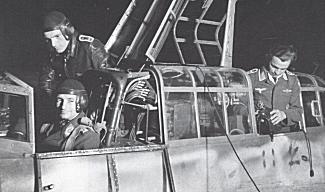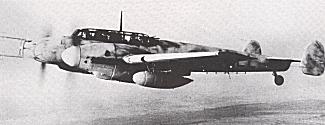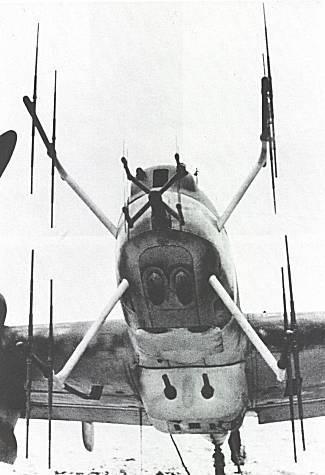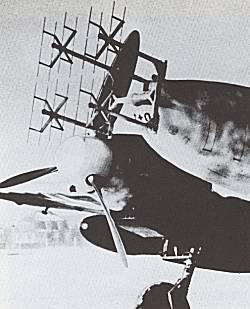L'estate del 1941 segna l'inizio dell'applicazione del sistema
Himmelbett che rimmarrà in vigore fino alla fine del
conflitto.
Le stazioni di Himmelbett erano dotate di:
- Un radar Freya per acquisire il bersaglio a distanza (150 Km.
circa)
- Un radar Wurzburg-Riese per l'acquisizione dei bombardieri
nemici
- Un radar Wurzburg-Riese per il controllo dei caccia
notturni.
- Tre caccia pronti al decollo
Con questa dotazione la tattica era quella di agganciare i
bombardieri a circa 150 Km di distanza e le informazioni
passavano ai radar Wurzburg per il controllo dei bombardieri. A
questo punto i Wurzburg per il controllo caccia, dirigevano
questi verso i bombardieri. Purtroppo il punto debole era dato
dal fatto che in ogni singola area territoriale c'era un solo
caccia (gli altri due erano a disposizione). Ben presto gli
inglesi capirono che concentrando molti bombardieri in una sola
area, potevano incontrare al massimo tre velivoli da caccia
notturna.
Il sistema venne in seguito modificato.

Missioni diurne, un sacrificio senza
senso
Alcuni episodi nella difesa aerea del Reich, indicano il livello
didisperazione in cui versava la Luftwaffe
nell'assolvere al compito di proteggere il proprio territorio. Si
era infatti pensato di impiegare i caccia notturni provvisti di
radar, contro i bombardieri diurni B-17.
Il Bf 110 G-4 era un velivolo troppo pesante per effettuare
manovre di caccia, ma al contempo era dotato delle strutture e
dell'armamento ideale per contrastare i bombardieri americani e
se contro questi c'era qualche possibilità di successo,
contro i caccia pesanti americani (P-47 e P-51) queste erano
assolutamente assenti.
Così alla sua prima missione il capitano Ludwig Becker, grande tattico della caccia
notturna, trovo la morte. Ben presto altri equipaggi andarono
incontro allo stesso destino e questo generò un altro tipo
di problema, il reperimento di equipaggi addestrati
adeguatamente.



Gli occhi elettronici della Caccia
Notturna
Lo sviluppo di ricerche in campo elettronico per la produzione di
radar e contromisure, rappresenta un interessante capitolo nella
storia della CN
tedesca della II^ G.M.
Gli ingegneri tedeschi svilupparono il FuG 227 Flensburg per essere avvertiti della presenza
del radar inglese Monica che equipaggiava i bombardieri.

Il primo radar di bordo ad essere impiegato operativamente fu il FuG 202 che aveva caratteristiche che permettevano di chiudere la breccia che si verificava tra le potenzialità del Wurzburg e l'obiettivo da raggiungere. Infatti il radar di terra conduceva il pilota nei pressi dell'obiettivo, ma tutto il resto dell'intercettazione doveva essere completato dal pilota. Con il FuG 202 il radiooperatore riusciva a condurre il pilota proprio sopra le formazioni dei bombardieri. A questo punto interveniva il sistema Naxos che intercettava le emissioni del radar inglese H2S e permetteva un ulteriore avvicinamento.
[ ... torna alla pagina precedente ] [ Continua ... ]
English version
The Himmelbett system
The summer of 1941 marks the beginning of the application of the
Himmelbett system that will remain in vigor until the end of the
conflict. The stations of Himmelbett were equipped of:
- a Freya radar in order at a distance to acquire the target (150
km. approximately)
- One Wurzburg-Riese radar for the acquisition of the enemy
bombers
- a Wurzburg-Riese radar for the nocturnal control of the
hunting.
- Three hunting ready to the takeoff
With this equipment the tactics was that one to couple the
bombers to approximately 150 Km of distance and the information
passed to the Wurzburg radars for the control of the bombers. To
this point the Wurzburg for the control hunting, the bombers
directed this back. Unfortunately the point weak was given from
the fact that in every single territorial area was a single
hunting (the others two was to disposition). Very soon English
understood that concentrating many bombers in a single area, they
could meet to the maximum three aircrafts from nocturnal hunting.
The system came later on modified.
Diurnal missions, senseless sacrifice
Some episodes in the aerial defense of the Reich, indicate the
level of desperation in which it poured the Luftwaffe in
acquitting to the task protect just the territory. In fact it had
been believed to employ the hunting nocturnal radar supplies,
against the diurnal bombers B-17. The Bf 110 G-4 was a too much
heavy aircraft in order to carry out hunting maneuvers, but it
was equipped of the structures and the ideal armament in order to
contrast the Americans bombers and if against these succeeding
were some possibility, against the hunting heavy Americans
hunting(P-47 and P-51) these were absolutely absent. Therefore to
its first mission captain Ludwig Becker, large tactical of the
nocturnal hunting, met is death. Very soon others crews went
encounter to the same destiny and this generated an other type of
problem, the finding of crews trained adequately.
The electronic eyes of the Nocturnal
Hunting
The development of searches in electronic field for the
production of radar and countermeasures, represents an
interesting chapter in the history of the German CN of II^ W.W.
The German engineers developed the FuG 227 Flensburg for being is
perceived of the presence of the English radar Monica that
equipped the bombers. The first radar of edge to being employed
operatively was FuG 202 that had characteristics that allowed to
close the rubble that took place between the potentialities of
the Wurzburg and the objective to catch up. In fact the earth
radar lead the pilot in proximity of the target, but all the rest
of the interception had to be completed from the pilot. With FuG
202 the radiooperator succeeded to lead the pilot just over the
bombers formations. To this point the Naxos system took part that
intercepted the emissions of English radar H2S and allowed an
ulterior approach.
[ ... back to
previous page ] [ Continue ... ]